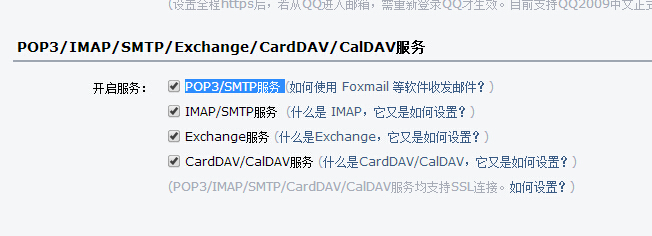Java 发送邮件
来源:互联网 发布:虚拟机安装ubuntu分区 编辑:程序博客网 时间:2024/05/29 11:57
Java 发送邮件
使用Java应用程序发送E-mail十分简单,但是首先你应该在你的机器上安装JavaMail API 和Java Activation Framework (JAF) 。
你可以在 JavaMail (Version 1.2) 下载最新的版本。
你可以再 在JAF (Version 1.1.1)下载最新的版本。
下载并解压这些文件,最上层文件夹你会发现很多的jar文件。你需要将mail.jar和activation.jar 添加到你的CLASSPATH中。
如果你使用第三方邮件服务器如QQ的SMTP服务器,可查看文章底部用户认证完整的实例。
发送一封简单的 E-mail
下面是一个发送简单E-mail的例子。假设你的localhost已经连接到网络。
// 文件名 SendEmail.java import java.util.*;import javax.mail.*;import javax.mail.internet.*;import javax.activation.*; public class SendEmail{ public static void main(String [] args) { // 收件人电子邮箱 String to = "abcd@gmail.com"; // 发件人电子邮箱 String from = "web@gmail.com"; // 指定发送邮件的主机为 localhost String host = "localhost"; // 获取系统属性 Properties properties = System.getProperties(); // 设置邮件服务器 properties.setProperty("mail.smtp.host", host); // 获取默认session对象 Session session = Session.getDefaultInstance(properties); try{ // 创建默认的 MimeMessage 对象 MimeMessage message = new MimeMessage(session); // Set From: 头部头字段 message.setFrom(new InternetAddress(from)); // Set To: 头部头字段 message.addRecipient(Message.RecipientType.TO, new InternetAddress(to)); // Set Subject: 头部头字段 message.setSubject("This is the Subject Line!"); // 设置消息体 message.setText("This is actual message"); // 发送消息 Transport.send(message); System.out.println("Sent message successfully...."); }catch (MessagingException mex) { mex.printStackTrace(); } }}编译并运行这个程序来发送一封简单的E-mail:
$ java SendEmailSent message successfully....
如果你想发送一封e-mail给多个收件人,那么使用下面的方法来指定多个收件人ID:
void addRecipients(Message.RecipientType type, Address[] addresses)throws MessagingException
下面是对于参数的描述:
type:要被设置为TO, CC 或者BCC. 这里CC 代表抄送、BCC 代表秘密抄送y. 举例:Message.RecipientType.TO
addresses: 这是email ID的数组。在指定电子邮件ID时,你将需要使用InternetAddress()方法。
发送一封HTML E-mail
下面是一个发送HTML E-mail的例子。假设你的localhost已经连接到网络。
和上一个例子很相似,除了我们要使用setContent()方法来通过第二个参数为"text/html",来设置内容来指定要发送HTML内容。
// 文件名 SendHTMLEmail.java import java.util.*;import javax.mail.*;import javax.mail.internet.*;import javax.activation.*; public class SendHTMLEmail{ public static void main(String [] args) { // 收件人电子邮箱 String to = "abcd@gmail.com"; // 发件人电子邮箱 String from = "web@gmail.com"; // 指定发送邮件的主机为 localhost String host = "localhost"; // 获取系统属性 Properties properties = System.getProperties(); // 设置邮件服务器 properties.setProperty("mail.smtp.host", host); // 获取默认的 Session 对象。 Session session = Session.getDefaultInstance(properties); try{ // 创建默认的 MimeMessage 对象。 MimeMessage message = new MimeMessage(session); // Set From: 头部头字段 message.setFrom(new InternetAddress(from)); // Set To: 头部头字段 message.addRecipient(Message.RecipientType.TO, new InternetAddress(to)); // Set Subject: 头字段 message.setSubject("This is the Subject Line!"); // 发送 HTML 消息, 可以插入html标签 message.setContent("<h1>This is actual message</h1>", "text/html" ); // 发送消息 Transport.send(message); System.out.println("Sent message successfully...."); }catch (MessagingException mex) { mex.printStackTrace(); } }}编译并运行此程序来发送HTML e-mail:
$ java SendHTMLEmailSent message successfully....
发送带有附件的 E-mail
下面是一个发送带有附件的 E-mail的例子。假设你的localhost已经连接到网络。
// 文件名 SendFileEmail.java import java.util.*;import javax.mail.*;import javax.mail.internet.*;import javax.activation.*; public class SendFileEmail{ public static void main(String [] args) { // 收件人电子邮箱 String to = "abcd@gmail.com"; // 发件人电子邮箱 String from = "web@gmail.com"; // 指定发送邮件的主机为 localhost String host = "localhost"; // 获取系统属性 Properties properties = System.getProperties(); // 设置邮件服务器 properties.setProperty("mail.smtp.host", host); // 获取默认的 Session 对象。 Session session = Session.getDefaultInstance(properties); try{ // 创建默认的 MimeMessage 对象。 MimeMessage message = new MimeMessage(session); // Set From: 头部头字段 message.setFrom(new InternetAddress(from)); // Set To: 头部头字段 message.addRecipient(Message.RecipientType.TO, new InternetAddress(to)); // Set Subject: 头字段 message.setSubject("This is the Subject Line!"); // 创建消息部分 BodyPart messageBodyPart = new MimeBodyPart(); // 消息 messageBodyPart.setText("This is message body"); // 创建多重消息 Multipart multipart = new MimeMultipart(); // 设置文本消息部分 multipart.addBodyPart(messageBodyPart); // 附件部分 messageBodyPart = new MimeBodyPart(); String filename = "file.txt"; DataSource source = new FileDataSource(filename); messageBodyPart.setDataHandler(new DataHandler(source)); messageBodyPart.setFileName(filename); multipart.addBodyPart(messageBodyPart); // 发送完整消息 message.setContent(multipart ); // 发送消息 Transport.send(message); System.out.println("Sent message successfully...."); }catch (MessagingException mex) { mex.printStackTrace(); } }}编译并运行你的程序来发送一封带有附件的邮件。
$ java SendFileEmailSent message successfully....
用户认证部分
如果需要提供用户名和密码给e-mail服务器来达到用户认证的目的,你可以通过如下设置来完成:
props.put("mail.smtp.auth", "true"); props.setProperty("mail.user", "myuser"); props.setProperty("mail.password", "mypwd");e-mail其他的发送机制和上述保持一致。
需要用户名密码验证邮件发送实例:
本实例以QQ邮件服务器为例,你需要在登录QQ邮箱后台在"设置"=》账号中开启POP3/SMTP服务 ,如下图所示:

Java 代码如下:
// 需要用户名密码邮件发送实例//文件名 SendEmail2.java//本实例以QQ邮箱为例,你需要在qq后台设置import java.util.Properties;import javax.mail.Authenticator;import javax.mail.Message;import javax.mail.MessagingException;import javax.mail.PasswordAuthentication;import javax.mail.Session;import javax.mail.Transport;import javax.mail.internet.InternetAddress;import javax.mail.internet.MimeMessage;public class SendEmail2{ public static void main(String [] args) { // 收件人电子邮箱 String to = "xxx@qq.com"; // 发件人电子邮箱 String from = "xxx@qq.com"; // 指定发送邮件的主机为 localhost String host = "smtp.qq.com"; //QQ 邮件服务器 // 获取系统属性 Properties properties = System.getProperties(); // 设置邮件服务器 properties.setProperty("mail.smtp.host", host); properties.put("mail.smtp.auth", "true"); // 获取默认session对象 Session session = Session.getDefaultInstance(properties,new Authenticator(){ public PasswordAuthentication getPasswordAuthentication() { return new PasswordAuthentication("xxx@qq.com", "qq邮箱密码"); //发件人邮件用户名、密码 } }); try{ // 创建默认的 MimeMessage 对象 MimeMessage message = new MimeMessage(session); // Set From: 头部头字段 message.setFrom(new InternetAddress(from)); // Set To: 头部头字段 message.addRecipient(Message.RecipientType.TO, new InternetAddress(to)); // Set Subject: 头部头字段 message.setSubject("This is the Subject Line!"); // 设置消息体 message.setText("This is actual message"); // 发送消息 Transport.send(message); System.out.println("Sent message successfully....from w3cschool.cn"); }catch (MessagingException mex) { mex.printStackTrace(); } }}- [java]Java发送邮件
- java 邮件发送 --- 简单的邮件发送
- JAVA发送邮件及springboot发送邮件
- 用java发送邮件
- 用Java发送邮件
- java发送邮件源码
- java发送邮件
- Java发送邮件
- Java发送邮件程序
- java发送Email邮件
- 怎样用java发送邮件
- 利用java发送邮件
- java 邮件发送
- java邮件发送
- java邮件发送
- java定时发送邮件
- java发送邮件代码
- Java Mail 发送邮件
- SpringMVC执行流程
- 走进编程
- MAKEWORD(2,2)解释
- LINUX USB device驱动
- JQuery 插件:、jQuery.Cookie.js
- Java 发送邮件
- C++重写(覆盖)、重载、重定义、多态
- 通过acpi_dev_found 区分不同的deviceid,通过dev_of_node和is_acpi_node 区分dt和ACPI
- Vue.js自定义指令的用法与实例
- mysql可能造成索引失效的场景
- 基于Spring框架的Shiro配置
- java中trim()方法的作用
- RA-01940:无法删除当前已链接的用户(转)
- java数据的排序方法


